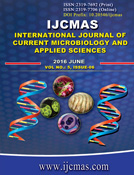


 National Academy of Agricultural Sciences (NAAS)
National Academy of Agricultural Sciences (NAAS)

|
PRINT ISSN : 2319-7692
Online ISSN : 2319-7706 Issues : 12 per year Publisher : Excellent Publishers Email : editorijcmas@gmail.com / submit@ijcmas.com Editor-in-chief: Dr.M.Prakash Index Copernicus ICV 2018: 95.39 NAAS RATING 2020: 5.38 |
Health-care-associated infection (HAI) is a major problem in hospitals worldwide. This study was conducted to describe culture-confirmed HAIs, its patterns of antibiotic resistance and risk factors for acquiring HAIs and multidrug resistant (MDR) pathogens. A retrospective analysis was made between January 2013 and August 2015 for HAIs among7063 patients in tropical medicine department in Mansoura University Hospital, Egypt. A total of 1658 samples were collected for culture, isolation, identification and antibiotic susceptibility of nosocomial pathogens. Multidrug resistant pathogens were characterized phenotypically and extended spectrum β lactamase (ESBL) production was assessed by modified double disc synergy test(MDDS). HAI rate was 2.4/100 admission and 5.07/1000 patient days. The most common site of infection was urinary tract infection (UTI) (45.2%) and the most frequent nosocomial pathogen was E.coli (27.9%). Multi drug resistant organisms (MDRO) accounted for 40.6% of all bacterial isolates. The highest prevalence of ESBL production was among E.coli (47.6%). Age >65 years; invasive device utilization; neutropenia, abdominal paracentes is and hospital stay longer than seven days were significantly associated with HAI occurrence. Multiple antibiotic therapy, use of beta lactam, invasive device utilization and hospital stay longer than seven days were significantly associated with MDRO acquisition. The cumulative incidence of HAI in this study was low; however, the high rates of UTI and multi-resistant pathogens necessitate urgent comprehensive interventions of infection control.
HAI,Multidrug resistant organisms,UTI.modified double disc synergy test(MDDS)
 |
 |
 |
 |
 |